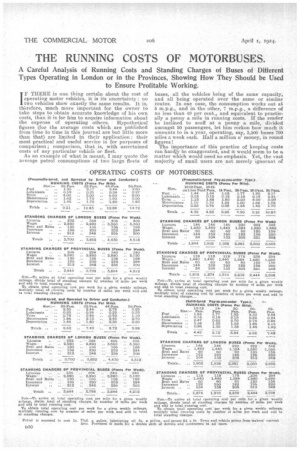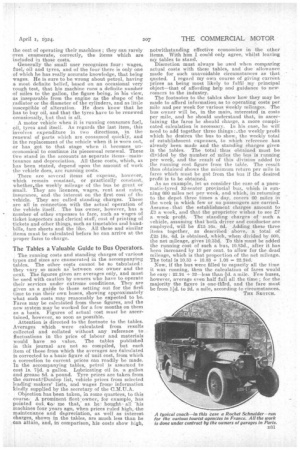THE RUNNING COSTS OF MOTORBUSES.
Page 24

Page 25

If you've noticed an error in this article please click here to report it so we can fix it.
A Careful Analysis of Running Costs and Standing Charges of Buses of Different Types Operating in London or in the Provinces, Showing How They Should be Used to Ensure Profitable Working.
IF THERE is one, thing certain about the cost of operating motor vehicles, it is its uncertainty : no two vehicles show exactly the same results. It is, therefore, much more important for the owner to take steps to obtain accurate knowledge of his own costs, than it is for him to acquire information about the expense of operating others. Hypothetical figures (for the average costs which are published from time to time in this journal are but little more than that) are limited in their application : their most practical and useful service is for purposes of comparison ; comparison, that.is, with ascertained costs of any particular vehicle or fleet. As an example of what is meant, I may quote the average petrol consumptions of two large fleets of buses, all the vehicles being of the same capacity, and all being operated over the same or similar routes. In one case, the consumption works out at 5 m.p.g., and in the other, 7 m.p.g., a difference of no less than 40 per cent, and equivalent to practic. ally a. penny a mile in running costs. If the reader be inclined to scoff at a penny a mile, divided amongst 50 passengers, let him reckon how much it amounts to in a year, operating, say, 3,500 buses 700 miles a week each. Half a million o' money, in round figures I The importance of this practice of keeping costa can hardly be exaggerated, and it would seem to be a matter which would need no emphasis. Yet, the vast majority of small users are not merely ignorant of the cost of operating their machines ; they can rarely even 'enumerate, correctly, the items which are included in those costs.
Generally the small user recognizes four : wages, fuels oil and tyres, and of the four there is only one of which he has really accurate knowledge, that being wages. He is sure to be wrong about petrol, having a most definite belief, based on an occasional very rough test, that his machine runs a definite number of miles to the gallon, the figure being, in his view, as inseparable from the engine as the shape of the radiator or the diameter of the cylinders, and as little susceptible of alteration. He does know that he has to buy oil, and that the tyres have to be renewed occasionally, but that is all.
A motor vehicle when it is running consumes fuel, oil, tyres and itself. As regards the last item, this involves expenditure in two directions, in the renewal of parts which are consumed quickly, and in the replacement of the vehicle when it is worn out, or has got. to that stage when it becomes uneconomical to continue its piecemeal renewal. These two stand in the accounts as •separate items—maintenance and depreciation. All these costs, which, as has been stated, depend upon the amount of work the vehicle does, are running costs.
There are several items of expense, however, which remain constant, or practically constant, whether.the weekly mileage of the bus be great or small. They are licences, wages, rent and rates, insurance, and the interest on the first cost of the vehicle. They are called standing charges. These are all in connection with the actual operation of the vehicle itself. The bus owner, however, has a number of other expenses to face, such as wages of ticket inspectors and clerical staff, cost of printing of tickets and other things, such as timetables and handbills, fare sheets and the like. All these and similar items must be calculated before he can arrive at the proper fares to charge.
The Tables a Valuable Guide to Bus Operators.
The running costs and standing charges of various types and sizes are enumerated in the accompanying tables. The other costs cannot be so tabulated : they vary so much as between one owner and the net. The figures given are averages only, and must be used with caution by owners who have to operate their services under extreme conditions. They are given as a guide to those .setting out for the first time to run their own buses, showing approximately what such costs may reasonably be expected to be. Fares may be calculated from these figures, and the new system may be worked for a few months on them as a basis. Figures of actual eost must be ascertained, however, so soon as possible. Attention is directed to the footnote to the tables. Averages which were calculated from results collected and collated without any referenceto fluctuations in the price of labour and materials would have no value. The tables published in this journal are not so compiled, but each item of those from which the averages are alculatect is corrected to a basic figure of unit cost, from which a correction to current prices can readily be made. In the accompanying tables, petrol is assumed to cost Is. 7id. a gallon. Lubricating oil 5s. -a gallon and grease 8d. a pound. Tyre prices are taken from the .currentSDunlop list, vehicle prices from selected leading makers' lists, and wages fron-e information kindly supplied by the secretary of the C.M.17.A. Objection has been taken, in some quarters, to this course: A prominent Ilee,t owner, for example, has pointed out, to) me that,' as he bought t all his machines four years ago, when prices ruled high, the maintenance and depreciation, as well as interest charges, shown in the tables, are much less than he can attain, and, in comparison, his costs show high,
notwithstanding effective economies in the other items. With him I could only agree, whilst leaving inY tables to stand. Discretion must always be used when comparing actual costs with these tables, and due allowance made for such unavoidable circumstances as that quoted. I regard my own course of giving current prices as being most likely to fulfil my principal object—that of affording help and guidance to 'newcomers to the industry.
The footnotes to the tables show how they may be made to afford information, as to operating costs per mile and per week for various Weekly mileages. The bus owner will be, in the main, interested in costs per mile, and he should understand that, in ascertaining the fares he should charge, a more complicated calculation is necessary. In his case, he will need to add together three things :.the weekly profit which he desires the bus to show, the weekly total of establishment expenses, to which reference has already been made and the standing charges given in the tables. The total thus obtained must be divided by the number of miles the bus is running per week, and the result of this division added to the running cost figure from the table. The result thus obtained shows the minimum return per mile in fares which must be got from the bus if the desired profit is to be obtained.
As an example, let us consider the case of a pneumatic-tyred 32-seater provincial bus, which is running 600 miles net per week, and which,, in returning to the depot three times a day, covers 60 miles in the week in which few or no passengers are carried. Assume . that the establishment charges amount to £3 a week, and that the proprietor wishes to see lit a week profit. The standing charges of such a vehicle, assuming that both driver and conductor are employed, will be £15 16s. 6d. Adding these three items together, as described above, a total. of £25 16s. 6d. is obtained, which, when divided by 600, the net mileage, gives 10.33d. To this must be added the running cost of such a bus, 10.83d., after it has been increased by 10 per cent. to allow for the. dead mileage, which is that proportion of the net mileage. The total is 10.33 ± 10.83 ± 1.08 = 22.24d.
Now, if the bus were filled -le capacity all the time it was running, then the calculation of fares would be easy : 22.24 ÷ 32—less than id. a mile. Few buses, however, average even half full all the time ; for the majority the figure is one-third, and the fare must be from 11d. to 2d. a mile, according to circumstances.
THE SKOTCH.






















































